GSBS6004: Organizational Behavior and Leadership Essay Analysis
VerifiedAdded on 2023/06/10
|8
|2784
|250
Essay
AI Summary
This essay critically examines the use of metaphors in understanding organizational behavior, as explored in the GSBS6004 course. It delves into various metaphors, including the political metaphor, to analyze competing interests and power relations within organizations. The essay highlights the importance of leadership in navigating these complexities and understanding employee behavior. It discusses the eight basic metaphors of organizational behavior, such as organizations as machines, organisms, brains, cultures, political systems, psychic prisons, systems of change and flux, and instruments of domination. The essay emphasizes how these metaphors, influenced by leadership qualities, shape the perception and interpretation of individuals within the organization and impact decision-making processes. The analysis covers how different metaphors offer varying perspectives on organizational dynamics and influence leadership strategies. The essay also examines the role of organizational culture, political systems, and the impact of power dynamics on organizational outcomes, concluding with a reflection on the importance of understanding these metaphors for effective organizational management.
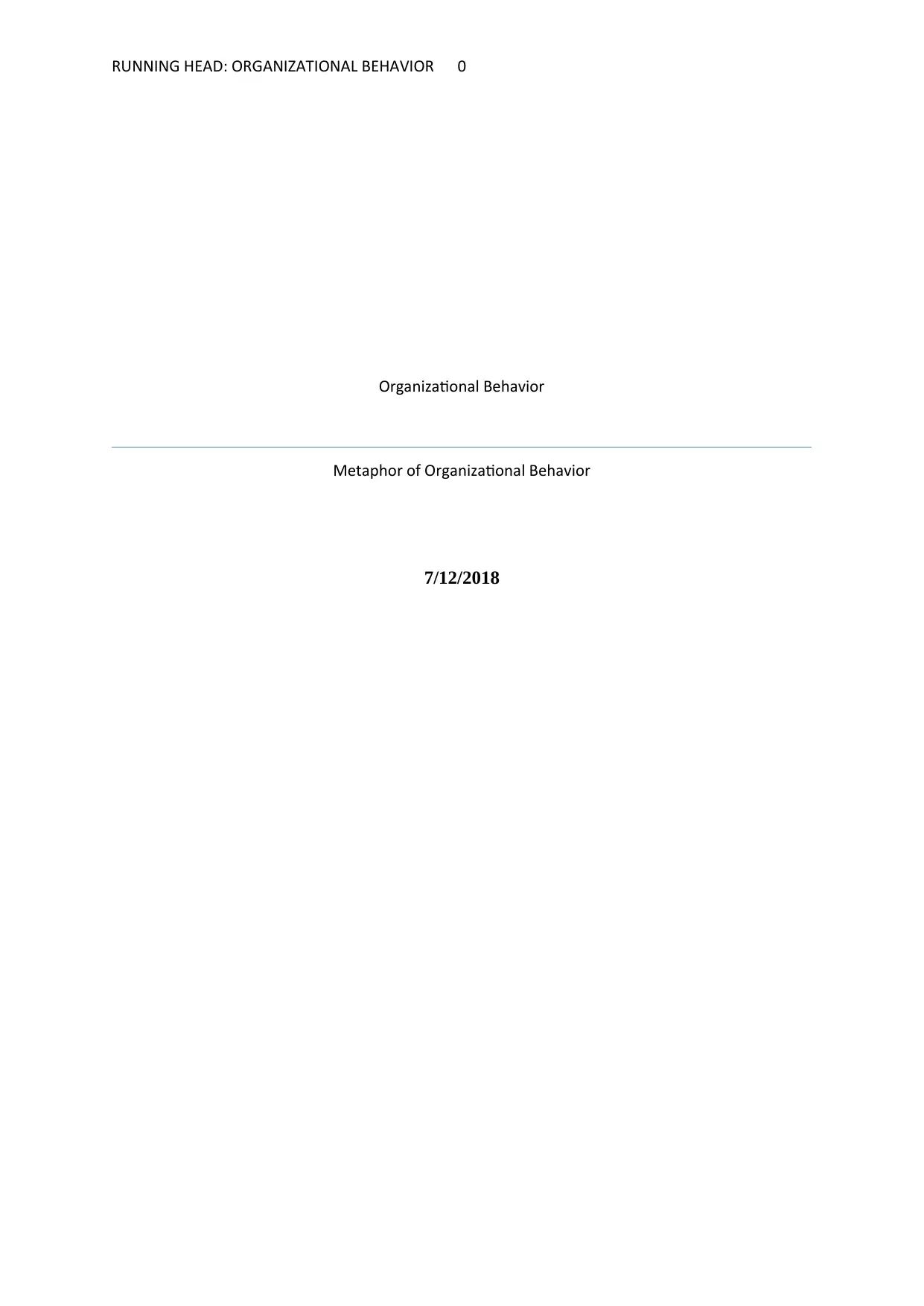
RUNNING HEAD: ORGANIZATIONAL BEHAVIOR 0
Organizational Behavior
Metaphor of Organizational Behavior
7/12/2018
Organizational Behavior
Metaphor of Organizational Behavior
7/12/2018
Paraphrase This Document
Need a fresh take? Get an instant paraphrase of this document with our AI Paraphraser
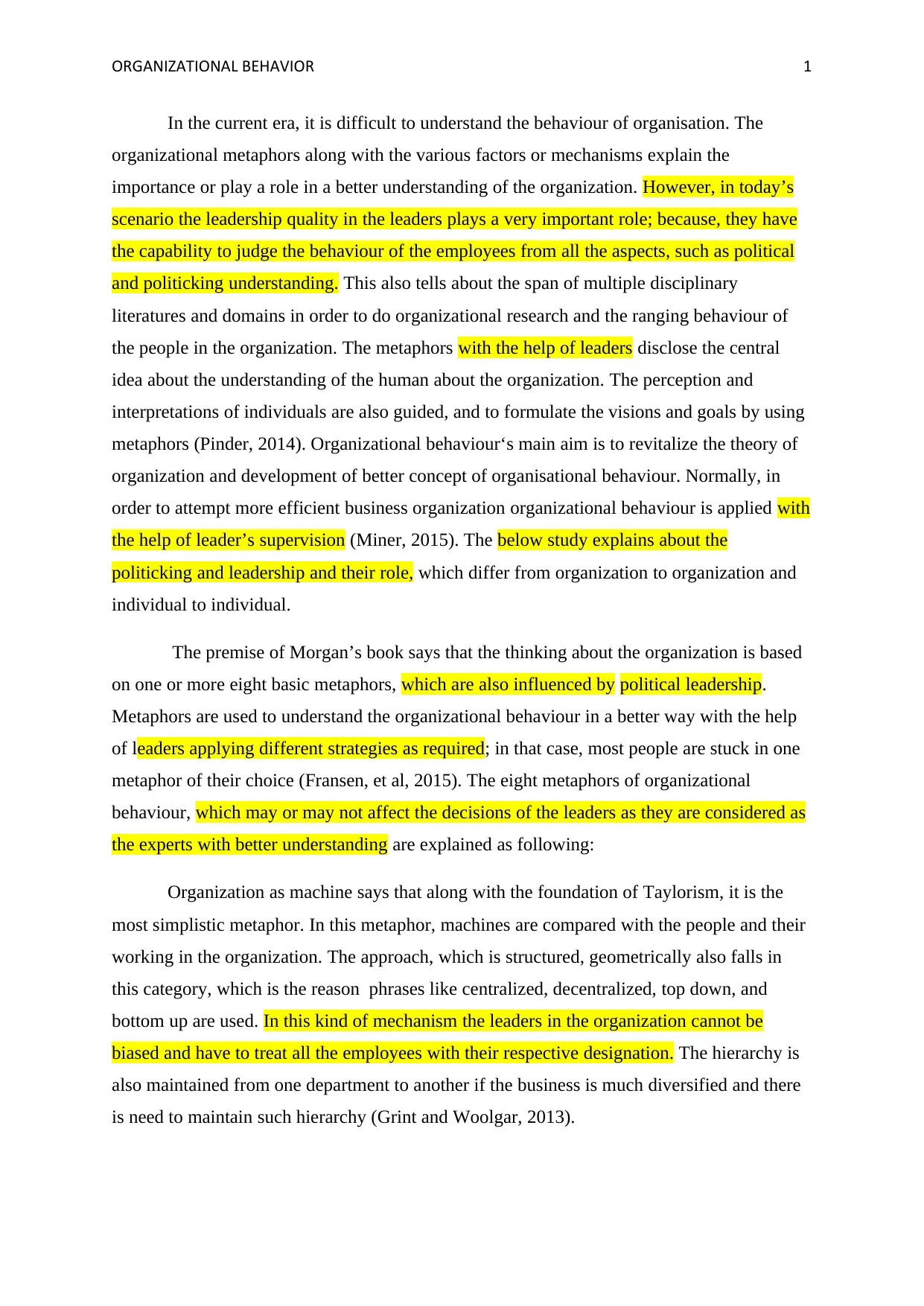
ORGANIZATIONAL BEHAVIOR 1
In the current era, it is difficult to understand the behaviour of organisation. The
organizational metaphors along with the various factors or mechanisms explain the
importance or play a role in a better understanding of the organization. However, in today’s
scenario the leadership quality in the leaders plays a very important role; because, they have
the capability to judge the behaviour of the employees from all the aspects, such as political
and politicking understanding. This also tells about the span of multiple disciplinary
literatures and domains in order to do organizational research and the ranging behaviour of
the people in the organization. The metaphors with the help of leaders disclose the central
idea about the understanding of the human about the organization. The perception and
interpretations of individuals are also guided, and to formulate the visions and goals by using
metaphors (Pinder, 2014). Organizational behaviour‘s main aim is to revitalize the theory of
organization and development of better concept of organisational behaviour. Normally, in
order to attempt more efficient business organization organizational behaviour is applied with
the help of leader’s supervision (Miner, 2015). The below study explains about the
politicking and leadership and their role, which differ from organization to organization and
individual to individual.
The premise of Morgan’s book says that the thinking about the organization is based
on one or more eight basic metaphors, which are also influenced by political leadership.
Metaphors are used to understand the organizational behaviour in a better way with the help
of leaders applying different strategies as required; in that case, most people are stuck in one
metaphor of their choice (Fransen, et al, 2015). The eight metaphors of organizational
behaviour, which may or may not affect the decisions of the leaders as they are considered as
the experts with better understanding are explained as following:
Organization as machine says that along with the foundation of Taylorism, it is the
most simplistic metaphor. In this metaphor, machines are compared with the people and their
working in the organization. The approach, which is structured, geometrically also falls in
this category, which is the reason phrases like centralized, decentralized, top down, and
bottom up are used. In this kind of mechanism the leaders in the organization cannot be
biased and have to treat all the employees with their respective designation. The hierarchy is
also maintained from one department to another if the business is much diversified and there
is need to maintain such hierarchy (Grint and Woolgar, 2013).
In the current era, it is difficult to understand the behaviour of organisation. The
organizational metaphors along with the various factors or mechanisms explain the
importance or play a role in a better understanding of the organization. However, in today’s
scenario the leadership quality in the leaders plays a very important role; because, they have
the capability to judge the behaviour of the employees from all the aspects, such as political
and politicking understanding. This also tells about the span of multiple disciplinary
literatures and domains in order to do organizational research and the ranging behaviour of
the people in the organization. The metaphors with the help of leaders disclose the central
idea about the understanding of the human about the organization. The perception and
interpretations of individuals are also guided, and to formulate the visions and goals by using
metaphors (Pinder, 2014). Organizational behaviour‘s main aim is to revitalize the theory of
organization and development of better concept of organisational behaviour. Normally, in
order to attempt more efficient business organization organizational behaviour is applied with
the help of leader’s supervision (Miner, 2015). The below study explains about the
politicking and leadership and their role, which differ from organization to organization and
individual to individual.
The premise of Morgan’s book says that the thinking about the organization is based
on one or more eight basic metaphors, which are also influenced by political leadership.
Metaphors are used to understand the organizational behaviour in a better way with the help
of leaders applying different strategies as required; in that case, most people are stuck in one
metaphor of their choice (Fransen, et al, 2015). The eight metaphors of organizational
behaviour, which may or may not affect the decisions of the leaders as they are considered as
the experts with better understanding are explained as following:
Organization as machine says that along with the foundation of Taylorism, it is the
most simplistic metaphor. In this metaphor, machines are compared with the people and their
working in the organization. The approach, which is structured, geometrically also falls in
this category, which is the reason phrases like centralized, decentralized, top down, and
bottom up are used. In this kind of mechanism the leaders in the organization cannot be
biased and have to treat all the employees with their respective designation. The hierarchy is
also maintained from one department to another if the business is much diversified and there
is need to maintain such hierarchy (Grint and Woolgar, 2013).
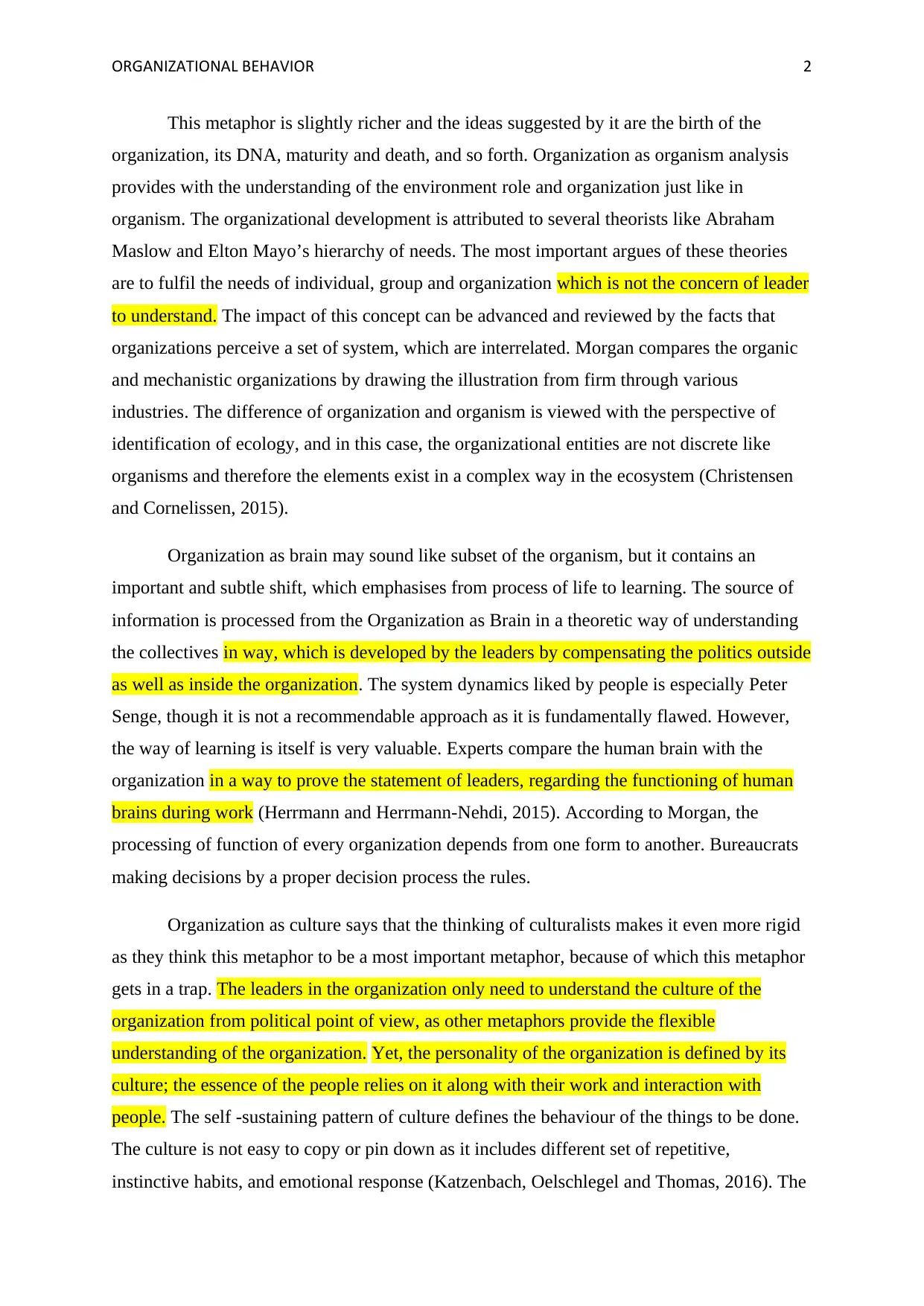
ORGANIZATIONAL BEHAVIOR 2
This metaphor is slightly richer and the ideas suggested by it are the birth of the
organization, its DNA, maturity and death, and so forth. Organization as organism analysis
provides with the understanding of the environment role and organization just like in
organism. The organizational development is attributed to several theorists like Abraham
Maslow and Elton Mayo’s hierarchy of needs. The most important argues of these theories
are to fulfil the needs of individual, group and organization which is not the concern of leader
to understand. The impact of this concept can be advanced and reviewed by the facts that
organizations perceive a set of system, which are interrelated. Morgan compares the organic
and mechanistic organizations by drawing the illustration from firm through various
industries. The difference of organization and organism is viewed with the perspective of
identification of ecology, and in this case, the organizational entities are not discrete like
organisms and therefore the elements exist in a complex way in the ecosystem (Christensen
and Cornelissen, 2015).
Organization as brain may sound like subset of the organism, but it contains an
important and subtle shift, which emphasises from process of life to learning. The source of
information is processed from the Organization as Brain in a theoretic way of understanding
the collectives in way, which is developed by the leaders by compensating the politics outside
as well as inside the organization. The system dynamics liked by people is especially Peter
Senge, though it is not a recommendable approach as it is fundamentally flawed. However,
the way of learning is itself is very valuable. Experts compare the human brain with the
organization in a way to prove the statement of leaders, regarding the functioning of human
brains during work (Herrmann and Herrmann-Nehdi, 2015). According to Morgan, the
processing of function of every organization depends from one form to another. Bureaucrats
making decisions by a proper decision process the rules.
Organization as culture says that the thinking of culturalists makes it even more rigid
as they think this metaphor to be a most important metaphor, because of which this metaphor
gets in a trap. The leaders in the organization only need to understand the culture of the
organization from political point of view, as other metaphors provide the flexible
understanding of the organization. Yet, the personality of the organization is defined by its
culture; the essence of the people relies on it along with their work and interaction with
people. The self -sustaining pattern of culture defines the behaviour of the things to be done.
The culture is not easy to copy or pin down as it includes different set of repetitive,
instinctive habits, and emotional response (Katzenbach, Oelschlegel and Thomas, 2016). The
This metaphor is slightly richer and the ideas suggested by it are the birth of the
organization, its DNA, maturity and death, and so forth. Organization as organism analysis
provides with the understanding of the environment role and organization just like in
organism. The organizational development is attributed to several theorists like Abraham
Maslow and Elton Mayo’s hierarchy of needs. The most important argues of these theories
are to fulfil the needs of individual, group and organization which is not the concern of leader
to understand. The impact of this concept can be advanced and reviewed by the facts that
organizations perceive a set of system, which are interrelated. Morgan compares the organic
and mechanistic organizations by drawing the illustration from firm through various
industries. The difference of organization and organism is viewed with the perspective of
identification of ecology, and in this case, the organizational entities are not discrete like
organisms and therefore the elements exist in a complex way in the ecosystem (Christensen
and Cornelissen, 2015).
Organization as brain may sound like subset of the organism, but it contains an
important and subtle shift, which emphasises from process of life to learning. The source of
information is processed from the Organization as Brain in a theoretic way of understanding
the collectives in way, which is developed by the leaders by compensating the politics outside
as well as inside the organization. The system dynamics liked by people is especially Peter
Senge, though it is not a recommendable approach as it is fundamentally flawed. However,
the way of learning is itself is very valuable. Experts compare the human brain with the
organization in a way to prove the statement of leaders, regarding the functioning of human
brains during work (Herrmann and Herrmann-Nehdi, 2015). According to Morgan, the
processing of function of every organization depends from one form to another. Bureaucrats
making decisions by a proper decision process the rules.
Organization as culture says that the thinking of culturalists makes it even more rigid
as they think this metaphor to be a most important metaphor, because of which this metaphor
gets in a trap. The leaders in the organization only need to understand the culture of the
organization from political point of view, as other metaphors provide the flexible
understanding of the organization. Yet, the personality of the organization is defined by its
culture; the essence of the people relies on it along with their work and interaction with
people. The self -sustaining pattern of culture defines the behaviour of the things to be done.
The culture is not easy to copy or pin down as it includes different set of repetitive,
instinctive habits, and emotional response (Katzenbach, Oelschlegel and Thomas, 2016). The
⊘ This is a preview!⊘
Do you want full access?
Subscribe today to unlock all pages.

Trusted by 1+ million students worldwide
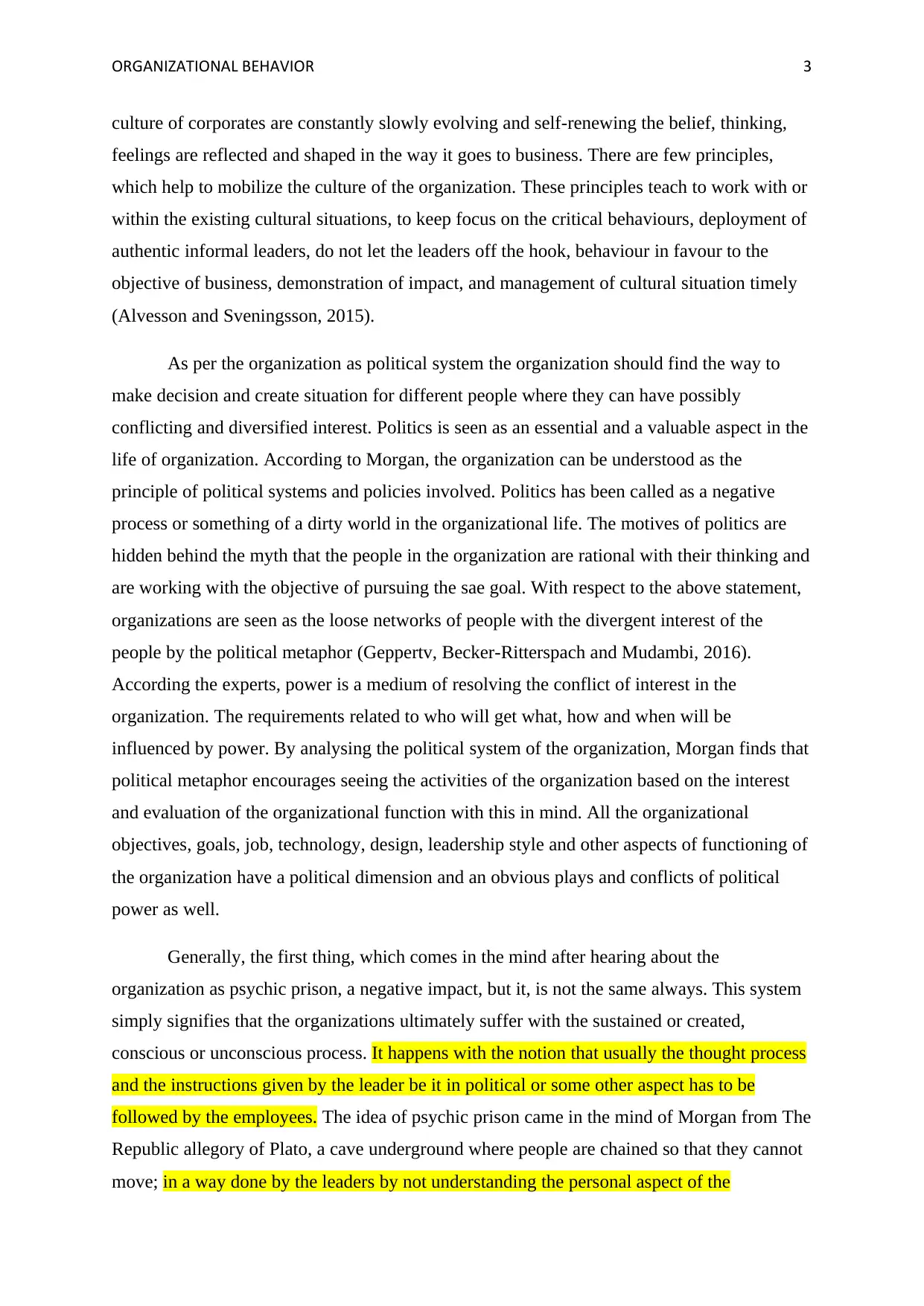
ORGANIZATIONAL BEHAVIOR 3
culture of corporates are constantly slowly evolving and self-renewing the belief, thinking,
feelings are reflected and shaped in the way it goes to business. There are few principles,
which help to mobilize the culture of the organization. These principles teach to work with or
within the existing cultural situations, to keep focus on the critical behaviours, deployment of
authentic informal leaders, do not let the leaders off the hook, behaviour in favour to the
objective of business, demonstration of impact, and management of cultural situation timely
(Alvesson and Sveningsson, 2015).
As per the organization as political system the organization should find the way to
make decision and create situation for different people where they can have possibly
conflicting and diversified interest. Politics is seen as an essential and a valuable aspect in the
life of organization. According to Morgan, the organization can be understood as the
principle of political systems and policies involved. Politics has been called as a negative
process or something of a dirty world in the organizational life. The motives of politics are
hidden behind the myth that the people in the organization are rational with their thinking and
are working with the objective of pursuing the sae goal. With respect to the above statement,
organizations are seen as the loose networks of people with the divergent interest of the
people by the political metaphor (Geppertv, Becker-Ritterspach and Mudambi, 2016).
According the experts, power is a medium of resolving the conflict of interest in the
organization. The requirements related to who will get what, how and when will be
influenced by power. By analysing the political system of the organization, Morgan finds that
political metaphor encourages seeing the activities of the organization based on the interest
and evaluation of the organizational function with this in mind. All the organizational
objectives, goals, job, technology, design, leadership style and other aspects of functioning of
the organization have a political dimension and an obvious plays and conflicts of political
power as well.
Generally, the first thing, which comes in the mind after hearing about the
organization as psychic prison, a negative impact, but it, is not the same always. This system
simply signifies that the organizations ultimately suffer with the sustained or created,
conscious or unconscious process. It happens with the notion that usually the thought process
and the instructions given by the leader be it in political or some other aspect has to be
followed by the employees. The idea of psychic prison came in the mind of Morgan from The
Republic allegory of Plato, a cave underground where people are chained so that they cannot
move; in a way done by the leaders by not understanding the personal aspect of the
culture of corporates are constantly slowly evolving and self-renewing the belief, thinking,
feelings are reflected and shaped in the way it goes to business. There are few principles,
which help to mobilize the culture of the organization. These principles teach to work with or
within the existing cultural situations, to keep focus on the critical behaviours, deployment of
authentic informal leaders, do not let the leaders off the hook, behaviour in favour to the
objective of business, demonstration of impact, and management of cultural situation timely
(Alvesson and Sveningsson, 2015).
As per the organization as political system the organization should find the way to
make decision and create situation for different people where they can have possibly
conflicting and diversified interest. Politics is seen as an essential and a valuable aspect in the
life of organization. According to Morgan, the organization can be understood as the
principle of political systems and policies involved. Politics has been called as a negative
process or something of a dirty world in the organizational life. The motives of politics are
hidden behind the myth that the people in the organization are rational with their thinking and
are working with the objective of pursuing the sae goal. With respect to the above statement,
organizations are seen as the loose networks of people with the divergent interest of the
people by the political metaphor (Geppertv, Becker-Ritterspach and Mudambi, 2016).
According the experts, power is a medium of resolving the conflict of interest in the
organization. The requirements related to who will get what, how and when will be
influenced by power. By analysing the political system of the organization, Morgan finds that
political metaphor encourages seeing the activities of the organization based on the interest
and evaluation of the organizational function with this in mind. All the organizational
objectives, goals, job, technology, design, leadership style and other aspects of functioning of
the organization have a political dimension and an obvious plays and conflicts of political
power as well.
Generally, the first thing, which comes in the mind after hearing about the
organization as psychic prison, a negative impact, but it, is not the same always. This system
simply signifies that the organizations ultimately suffer with the sustained or created,
conscious or unconscious process. It happens with the notion that usually the thought process
and the instructions given by the leader be it in political or some other aspect has to be
followed by the employees. The idea of psychic prison came in the mind of Morgan from The
Republic allegory of Plato, a cave underground where people are chained so that they cannot
move; in a way done by the leaders by not understanding the personal aspect of the
Paraphrase This Document
Need a fresh take? Get an instant paraphrase of this document with our AI Paraphraser
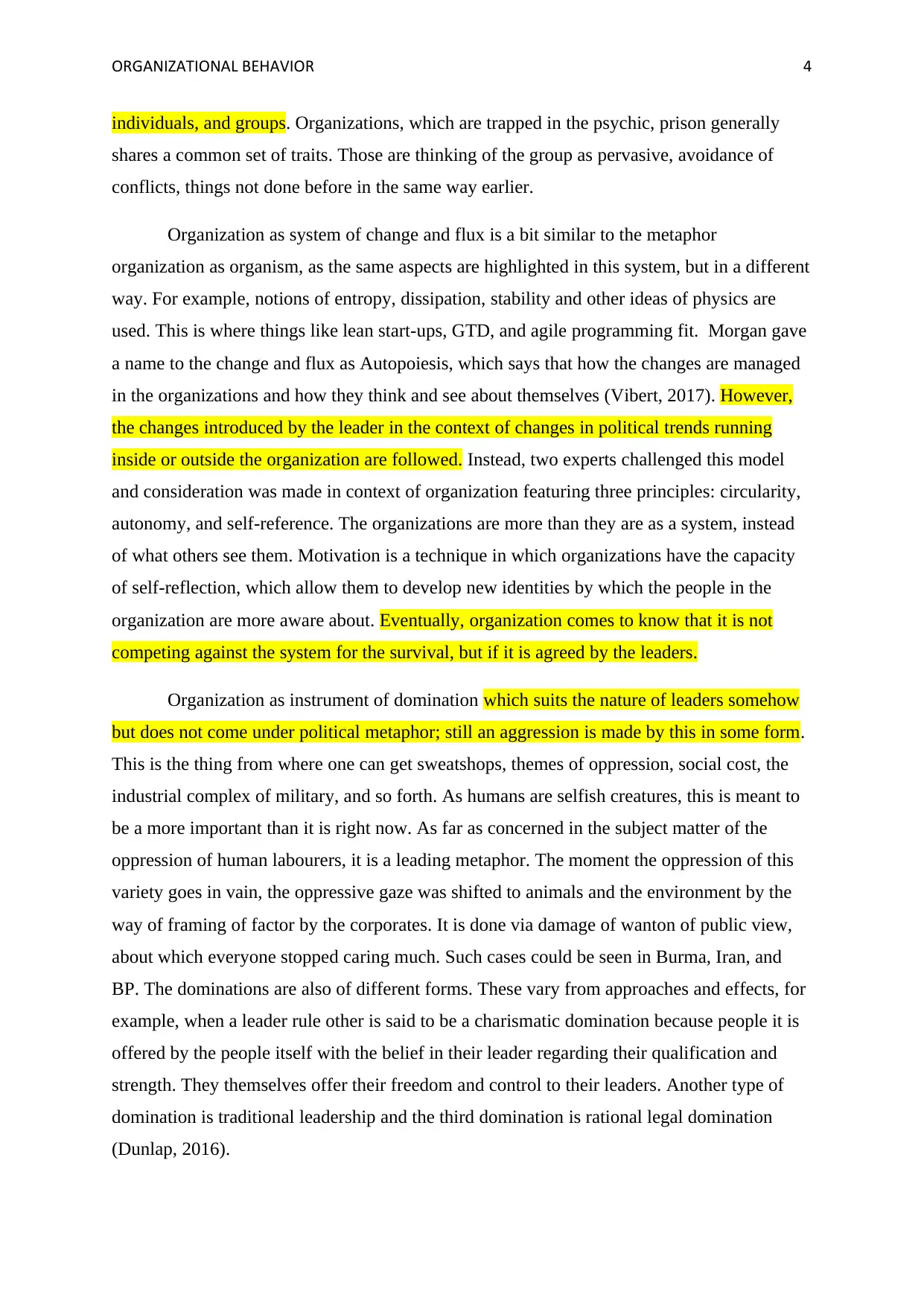
ORGANIZATIONAL BEHAVIOR 4
individuals, and groups. Organizations, which are trapped in the psychic, prison generally
shares a common set of traits. Those are thinking of the group as pervasive, avoidance of
conflicts, things not done before in the same way earlier.
Organization as system of change and flux is a bit similar to the metaphor
organization as organism, as the same aspects are highlighted in this system, but in a different
way. For example, notions of entropy, dissipation, stability and other ideas of physics are
used. This is where things like lean start-ups, GTD, and agile programming fit. Morgan gave
a name to the change and flux as Autopoiesis, which says that how the changes are managed
in the organizations and how they think and see about themselves (Vibert, 2017). However,
the changes introduced by the leader in the context of changes in political trends running
inside or outside the organization are followed. Instead, two experts challenged this model
and consideration was made in context of organization featuring three principles: circularity,
autonomy, and self-reference. The organizations are more than they are as a system, instead
of what others see them. Motivation is a technique in which organizations have the capacity
of self-reflection, which allow them to develop new identities by which the people in the
organization are more aware about. Eventually, organization comes to know that it is not
competing against the system for the survival, but if it is agreed by the leaders.
Organization as instrument of domination which suits the nature of leaders somehow
but does not come under political metaphor; still an aggression is made by this in some form.
This is the thing from where one can get sweatshops, themes of oppression, social cost, the
industrial complex of military, and so forth. As humans are selfish creatures, this is meant to
be a more important than it is right now. As far as concerned in the subject matter of the
oppression of human labourers, it is a leading metaphor. The moment the oppression of this
variety goes in vain, the oppressive gaze was shifted to animals and the environment by the
way of framing of factor by the corporates. It is done via damage of wanton of public view,
about which everyone stopped caring much. Such cases could be seen in Burma, Iran, and
BP. The dominations are also of different forms. These vary from approaches and effects, for
example, when a leader rule other is said to be a charismatic domination because people it is
offered by the people itself with the belief in their leader regarding their qualification and
strength. They themselves offer their freedom and control to their leaders. Another type of
domination is traditional leadership and the third domination is rational legal domination
(Dunlap, 2016).
individuals, and groups. Organizations, which are trapped in the psychic, prison generally
shares a common set of traits. Those are thinking of the group as pervasive, avoidance of
conflicts, things not done before in the same way earlier.
Organization as system of change and flux is a bit similar to the metaphor
organization as organism, as the same aspects are highlighted in this system, but in a different
way. For example, notions of entropy, dissipation, stability and other ideas of physics are
used. This is where things like lean start-ups, GTD, and agile programming fit. Morgan gave
a name to the change and flux as Autopoiesis, which says that how the changes are managed
in the organizations and how they think and see about themselves (Vibert, 2017). However,
the changes introduced by the leader in the context of changes in political trends running
inside or outside the organization are followed. Instead, two experts challenged this model
and consideration was made in context of organization featuring three principles: circularity,
autonomy, and self-reference. The organizations are more than they are as a system, instead
of what others see them. Motivation is a technique in which organizations have the capacity
of self-reflection, which allow them to develop new identities by which the people in the
organization are more aware about. Eventually, organization comes to know that it is not
competing against the system for the survival, but if it is agreed by the leaders.
Organization as instrument of domination which suits the nature of leaders somehow
but does not come under political metaphor; still an aggression is made by this in some form.
This is the thing from where one can get sweatshops, themes of oppression, social cost, the
industrial complex of military, and so forth. As humans are selfish creatures, this is meant to
be a more important than it is right now. As far as concerned in the subject matter of the
oppression of human labourers, it is a leading metaphor. The moment the oppression of this
variety goes in vain, the oppressive gaze was shifted to animals and the environment by the
way of framing of factor by the corporates. It is done via damage of wanton of public view,
about which everyone stopped caring much. Such cases could be seen in Burma, Iran, and
BP. The dominations are also of different forms. These vary from approaches and effects, for
example, when a leader rule other is said to be a charismatic domination because people it is
offered by the people itself with the belief in their leader regarding their qualification and
strength. They themselves offer their freedom and control to their leaders. Another type of
domination is traditional leadership and the third domination is rational legal domination
(Dunlap, 2016).
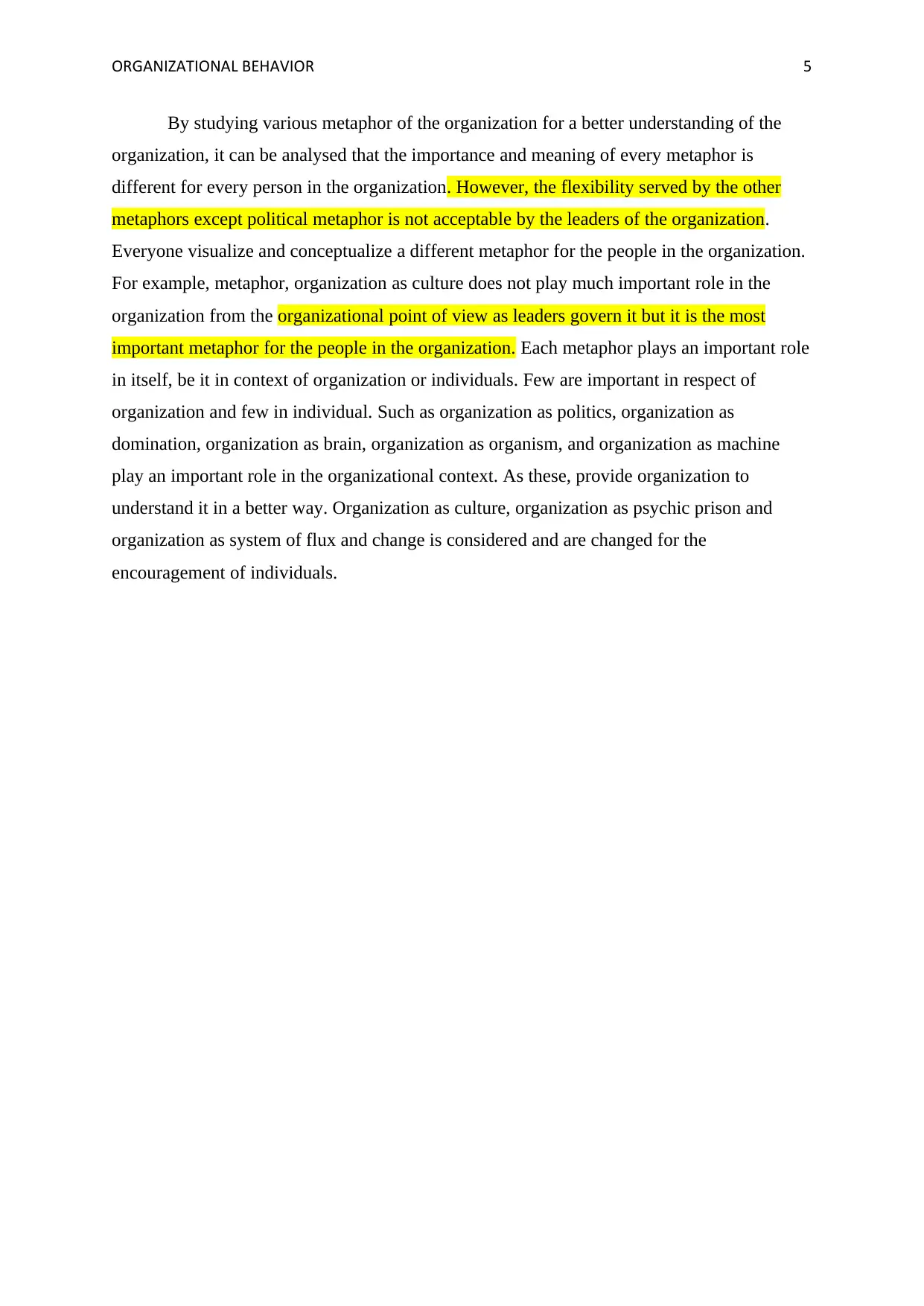
ORGANIZATIONAL BEHAVIOR 5
By studying various metaphor of the organization for a better understanding of the
organization, it can be analysed that the importance and meaning of every metaphor is
different for every person in the organization. However, the flexibility served by the other
metaphors except political metaphor is not acceptable by the leaders of the organization.
Everyone visualize and conceptualize a different metaphor for the people in the organization.
For example, metaphor, organization as culture does not play much important role in the
organization from the organizational point of view as leaders govern it but it is the most
important metaphor for the people in the organization. Each metaphor plays an important role
in itself, be it in context of organization or individuals. Few are important in respect of
organization and few in individual. Such as organization as politics, organization as
domination, organization as brain, organization as organism, and organization as machine
play an important role in the organizational context. As these, provide organization to
understand it in a better way. Organization as culture, organization as psychic prison and
organization as system of flux and change is considered and are changed for the
encouragement of individuals.
By studying various metaphor of the organization for a better understanding of the
organization, it can be analysed that the importance and meaning of every metaphor is
different for every person in the organization. However, the flexibility served by the other
metaphors except political metaphor is not acceptable by the leaders of the organization.
Everyone visualize and conceptualize a different metaphor for the people in the organization.
For example, metaphor, organization as culture does not play much important role in the
organization from the organizational point of view as leaders govern it but it is the most
important metaphor for the people in the organization. Each metaphor plays an important role
in itself, be it in context of organization or individuals. Few are important in respect of
organization and few in individual. Such as organization as politics, organization as
domination, organization as brain, organization as organism, and organization as machine
play an important role in the organizational context. As these, provide organization to
understand it in a better way. Organization as culture, organization as psychic prison and
organization as system of flux and change is considered and are changed for the
encouragement of individuals.
⊘ This is a preview!⊘
Do you want full access?
Subscribe today to unlock all pages.

Trusted by 1+ million students worldwide
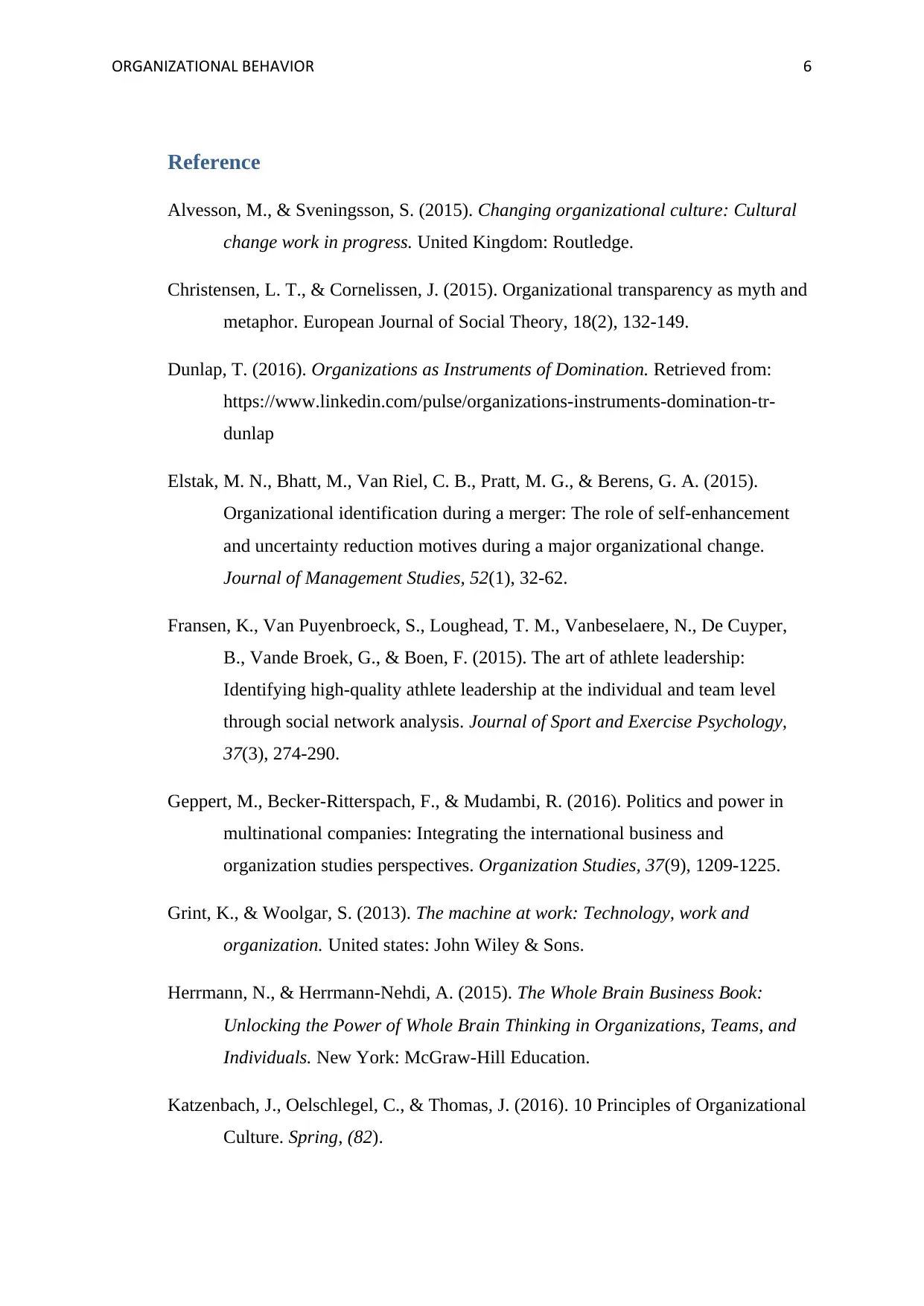
ORGANIZATIONAL BEHAVIOR 6
Reference
Alvesson, M., & Sveningsson, S. (2015). Changing organizational culture: Cultural
change work in progress. United Kingdom: Routledge.
Christensen, L. T., & Cornelissen, J. (2015). Organizational transparency as myth and
metaphor. European Journal of Social Theory, 18(2), 132-149.
Dunlap, T. (2016). Organizations as Instruments of Domination. Retrieved from:
https://www.linkedin.com/pulse/organizations-instruments-domination-tr-
dunlap
Elstak, M. N., Bhatt, M., Van Riel, C. B., Pratt, M. G., & Berens, G. A. (2015).
Organizational identification during a merger: The role of self‐enhancement
and uncertainty reduction motives during a major organizational change.
Journal of Management Studies, 52(1), 32-62.
Fransen, K., Van Puyenbroeck, S., Loughead, T. M., Vanbeselaere, N., De Cuyper,
B., Vande Broek, G., & Boen, F. (2015). The art of athlete leadership:
Identifying high-quality athlete leadership at the individual and team level
through social network analysis. Journal of Sport and Exercise Psychology,
37(3), 274-290.
Geppert, M., Becker-Ritterspach, F., & Mudambi, R. (2016). Politics and power in
multinational companies: Integrating the international business and
organization studies perspectives. Organization Studies, 37(9), 1209-1225.
Grint, K., & Woolgar, S. (2013). The machine at work: Technology, work and
organization. United states: John Wiley & Sons.
Herrmann, N., & Herrmann-Nehdi, A. (2015). The Whole Brain Business Book:
Unlocking the Power of Whole Brain Thinking in Organizations, Teams, and
Individuals. New York: McGraw-Hill Education.
Katzenbach, J., Oelschlegel, C., & Thomas, J. (2016). 10 Principles of Organizational
Culture. Spring, (82).
Reference
Alvesson, M., & Sveningsson, S. (2015). Changing organizational culture: Cultural
change work in progress. United Kingdom: Routledge.
Christensen, L. T., & Cornelissen, J. (2015). Organizational transparency as myth and
metaphor. European Journal of Social Theory, 18(2), 132-149.
Dunlap, T. (2016). Organizations as Instruments of Domination. Retrieved from:
https://www.linkedin.com/pulse/organizations-instruments-domination-tr-
dunlap
Elstak, M. N., Bhatt, M., Van Riel, C. B., Pratt, M. G., & Berens, G. A. (2015).
Organizational identification during a merger: The role of self‐enhancement
and uncertainty reduction motives during a major organizational change.
Journal of Management Studies, 52(1), 32-62.
Fransen, K., Van Puyenbroeck, S., Loughead, T. M., Vanbeselaere, N., De Cuyper,
B., Vande Broek, G., & Boen, F. (2015). The art of athlete leadership:
Identifying high-quality athlete leadership at the individual and team level
through social network analysis. Journal of Sport and Exercise Psychology,
37(3), 274-290.
Geppert, M., Becker-Ritterspach, F., & Mudambi, R. (2016). Politics and power in
multinational companies: Integrating the international business and
organization studies perspectives. Organization Studies, 37(9), 1209-1225.
Grint, K., & Woolgar, S. (2013). The machine at work: Technology, work and
organization. United states: John Wiley & Sons.
Herrmann, N., & Herrmann-Nehdi, A. (2015). The Whole Brain Business Book:
Unlocking the Power of Whole Brain Thinking in Organizations, Teams, and
Individuals. New York: McGraw-Hill Education.
Katzenbach, J., Oelschlegel, C., & Thomas, J. (2016). 10 Principles of Organizational
Culture. Spring, (82).
Paraphrase This Document
Need a fresh take? Get an instant paraphrase of this document with our AI Paraphraser
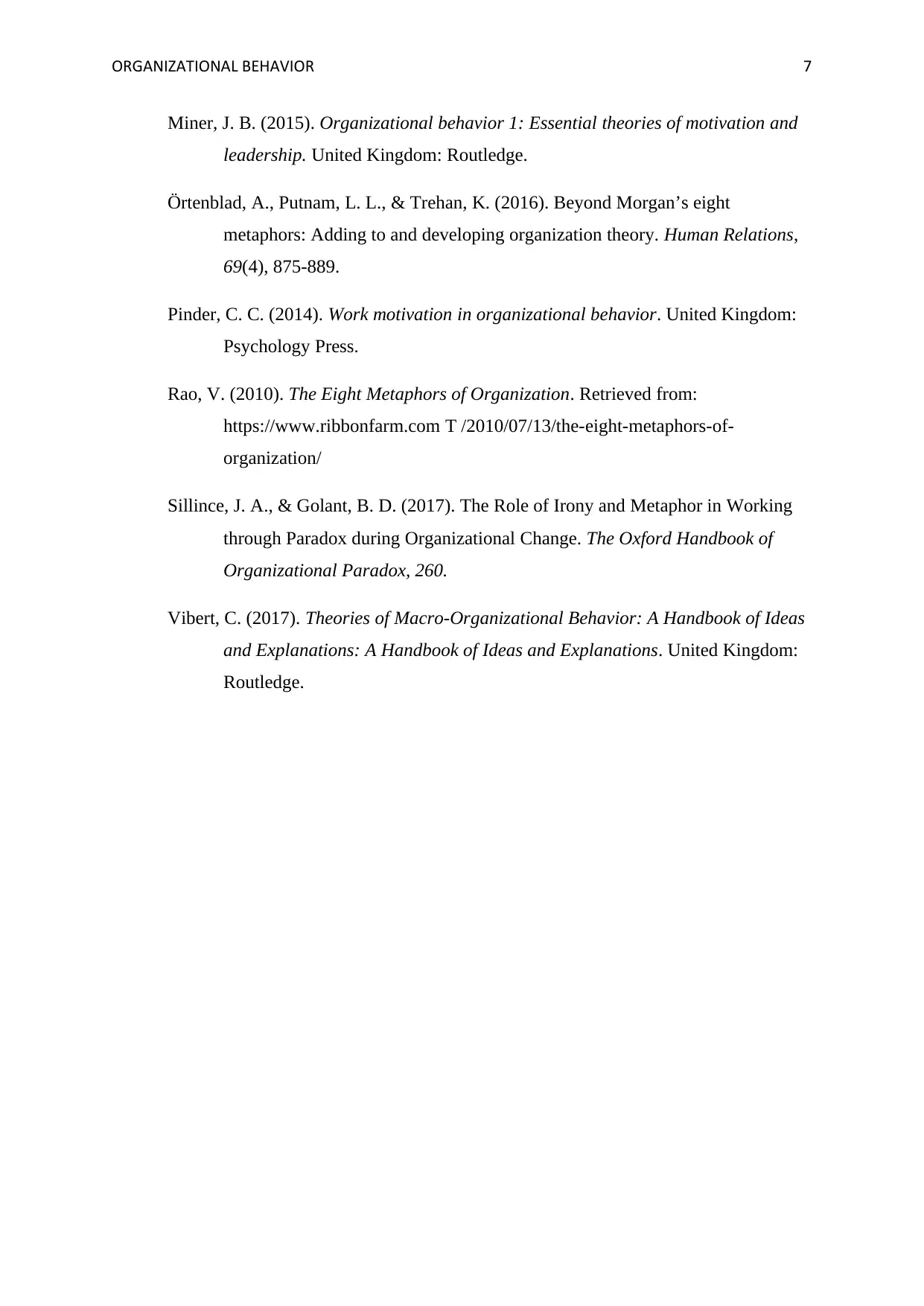
ORGANIZATIONAL BEHAVIOR 7
Miner, J. B. (2015). Organizational behavior 1: Essential theories of motivation and
leadership. United Kingdom: Routledge.
Örtenblad, A., Putnam, L. L., & Trehan, K. (2016). Beyond Morgan’s eight
metaphors: Adding to and developing organization theory. Human Relations,
69(4), 875-889.
Pinder, C. C. (2014). Work motivation in organizational behavior. United Kingdom:
Psychology Press.
Rao, V. (2010). The Eight Metaphors of Organization. Retrieved from:
https://www.ribbonfarm.com T /2010/07/13/the-eight-metaphors-of-
organization/
Sillince, J. A., & Golant, B. D. (2017). The Role of Irony and Metaphor in Working
through Paradox during Organizational Change. The Oxford Handbook of
Organizational Paradox, 260.
Vibert, C. (2017). Theories of Macro-Organizational Behavior: A Handbook of Ideas
and Explanations: A Handbook of Ideas and Explanations. United Kingdom:
Routledge.
Miner, J. B. (2015). Organizational behavior 1: Essential theories of motivation and
leadership. United Kingdom: Routledge.
Örtenblad, A., Putnam, L. L., & Trehan, K. (2016). Beyond Morgan’s eight
metaphors: Adding to and developing organization theory. Human Relations,
69(4), 875-889.
Pinder, C. C. (2014). Work motivation in organizational behavior. United Kingdom:
Psychology Press.
Rao, V. (2010). The Eight Metaphors of Organization. Retrieved from:
https://www.ribbonfarm.com T /2010/07/13/the-eight-metaphors-of-
organization/
Sillince, J. A., & Golant, B. D. (2017). The Role of Irony and Metaphor in Working
through Paradox during Organizational Change. The Oxford Handbook of
Organizational Paradox, 260.
Vibert, C. (2017). Theories of Macro-Organizational Behavior: A Handbook of Ideas
and Explanations: A Handbook of Ideas and Explanations. United Kingdom:
Routledge.
1 out of 8
Related Documents
Your All-in-One AI-Powered Toolkit for Academic Success.
+13062052269
info@desklib.com
Available 24*7 on WhatsApp / Email
![[object Object]](/_next/static/media/star-bottom.7253800d.svg)
Unlock your academic potential
Copyright © 2020–2025 A2Z Services. All Rights Reserved. Developed and managed by ZUCOL.





